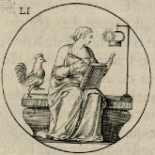Only in Lyon
Later this month, the North American Society for Seventeenth-Century French Literature (NASSCFL) will gather in Lyon for its 47th annual conference, devoted to the theme Literature, the Book and the Book Trade in Seventeenth-Century France.
To quote the organizers:
Lyon, the second printing center of the Ancien Régime after Paris, is the perfect place for such an investigation. Today, Lyon is still a special place for book history in France, through a strong network of schools and cultural institutions: the Book History Institute (IHL), the National Superior School for Library and Information Sciences (Enssib), the Lyon Public Library (BmL), the Museum of Printing and Graphic Communication (MICG). All of them have accepted to be our partners in the organization of the conference.
Fittingly, the conference will kick off with a panel on the book trade in Lyon, including a paper by Dominique Varry on “Lyon, capitale de la contrefaçon au XVIIe siècle.” Producing contrefaçons – illicit reprints of texts for which others had obtained a privilège du roi – became somewhat of a specialty of Lyon libraires in the 17th century, which is traditionally considered a period of decline for the trade after its “golden age” during the Renaissance. This development was due in part to royal policy, which increasingly favored Parisian printers and publishers over their provincial counterparts, more difficult to monitor and control.1
But not all Lyon reprints were piracies… and some of them can even reward the curious reader with bonuses not present in the Paris originals, nor anywhere else. A case in point is the 1703 edition of the Poësies de Madame Deshoulieres published “A Lyon, Chez Hilaire Baritel, ruë Merciere, à la Constance.” Copies can be found in various libraries and collections around the world, from Lyon (of course) to Toronto – though not in the BnF.
Hilaire Baritel is known in the annals of contrefaçon as the author of several texts denouncing the corrupt business practices of his colleagues.2 In a grievance filed in October 1702, he writes that during a recent stay in Paris he acquired “with much difficulty” a share of the privilège for four titles, including the works of Mme Deshoulières, and that his investment will be lost – and the authority of Louis XIV undermined – if other Lyon publishers are allowed to flood the market with their cheap piracies. His Deshoulières edition indeed includes the requisite Extrait du Privilege du Roy specifying that on August 11, 1702, the Paris publisher Jean Villette relinquished a portion of his rights in favor of Hilaire Baritel.
In addition to purchasing part of the privilège, Baritel commissioned a frontispiece for volume 1 of his edition: a portrait of Mme Deshoulières engraved by Étienne Jahandier Desrochers after a painting by Élisabeth-Sophie Chéron. (In fact, Desrochers probably copied the frontispiece of the 1695 Paris edition, engraved by Pierre van Schuppen after Chéron.)
But there’s more: Baritel actually augmented the Poësies with several unpublished texts, in particular three “Lettres de Gas chien de Madame Deshoulieres,” humorous epistles in the voice of the author’s spaniel. Two of them are addressed to “Madame de Chaulne, Abbesse de S. Pierre de Lyon,” and the third to “Madame de Chevry” – high-born nuns who had probably been close to Deshoulières when they lived in Paris (in the 1660s?), before moving to Lyon to lead the Benedictine abbey of Saint-Pierre. (The building now houses the Museum of Fine Arts.)
These poems are absent from Sophie Tonolo’s recent critical edition of Deshoulières’ Poésies, which does not take into account the 1703 publication.3 They do appear in the earlier edition by Catherine Hémon-Fabre and Pierre-Eugène Leroy, but with misleading information about their source and addressees.4 While the texts published by Baritel are not perfect, they seem authentic and could be among the earliest epistles composed by Deshoulières. The poet herself did not preserve them, but her Lyonnaise friends did, ensuring their eventual publication and survival. They deserve further study and raise a number of questions, the answers to which may well lie in Lyon. 5
Volker Schröder
June 11, 2017
Footnotes
1. See Henri-Jean Martin, Livre, pouvoirs et société à Paris au XVIIe siècle, Genève: Droz, 1999 [1969], p. 732-739.
2. See Eugène Griselle, La Contrefaçon en librairie à Lyon vers l’an 1702: mémoires et lettres autographes du libraire Baritel, premier adjoint de la Communauté des Libraires et Imprimeurs, Paris: Henri Leclerc, 1903, and Anne Béroujon, “Les réseaux de la contrefaçon de livres à Lyon dans la seconde moitié du XVIIe siècle,” Histoire et civilisation du livre II, 2006, Lyon et les livres, p. 85-112.
3. Madame Deshoulières, Poésies, ed. Sophie Tonolo, Paris: Classiques Garnier, 2010.
4. Antoinette Des Houlières, L’Enchantement des chagrins: Poésies complètes, ed. Catherine Hémon-Fabre and Pierre-Eugène Leroy, Paris: Bartillat, 2005, p. 25-30.
5. The additional poems also appear in a second Lyon edition, published (without date) by Antoine Besson, to whom Hilaire Baritel had now ceded his droit au privilège.



